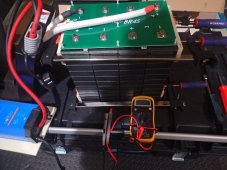Cool - now I know where the idea of bottom balancing came in. I've done it many times - but not for what we are doing here.
History - in the old days of diy EV's, bottom balancing was very popular. The reason being is that you would be only a block from home when your LVD would kick in.
But instead of pushing the EV a block to home, you would turn off the LVD, and limp back to your garage. The idea was that by doing so at bottom balance, all of the cells would hit the bottom at the same time, and non would go into reverse-polarity and be instantly trashed if they were out of balance at the bottom.
Most bottom balancers took their cells down to 2.7v, waited a day for the voltage to recover, discharge again and wait another day, discharge again and wait, and then proclaim that they were truly bottom balanced. But you are taking a big risk doing this manually, hence many opted for much bigger intelligent chargers with balance charge/discharge leads on them because of the inherent risk of doing this manually and taking cells down to zero by mistake.
In other words, bottom balancing is a very limited application scenario which you aren't in. You choose either one or the other method - not both.
For kicks, move the cells around to see if the problem follows the cell, or sticks with the slot. It is also possible that your multimeter isn't accurate. Maybe close enough for hobby work, but when dealing with LFP, where at the high end a 0.1V difference may be a go/no-go trigger, (like setting bleeders values between 3.4/3.5v etc), a Fluke out of the box (yes expensive) can be relied on. So can many other high-quality meters too. Just something to think about even though it may not fix your immediate issue.
Your BMS voltage readings can be off too. Let there be ONE standard to rule over all others. When doing LFP, a trusted meter is a must. Do you trust yours?





